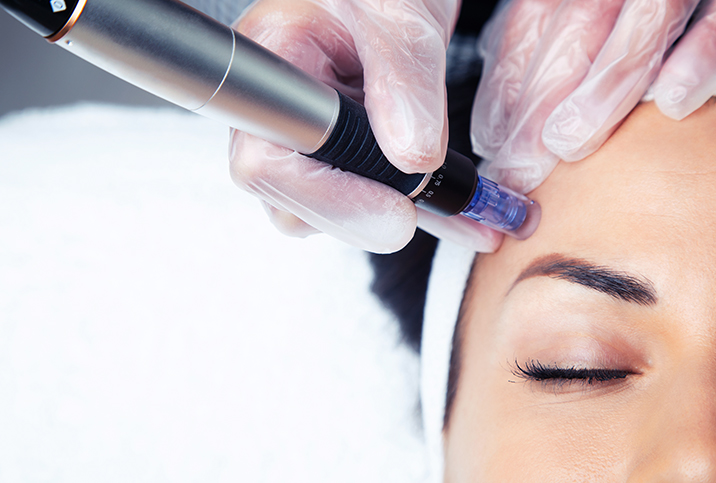Don't Worry, Mama. Stretch Marks Are Totally Normal During Pregnancy

Stretch marks, or striae, are a very common skin concern that can affect anyone. Chances are you have some yourself or you may know someone who does. While stretch marks can make an appearance in many situations, a common time to get them is during pregnancy, when your belly is stretched beyond its normal limits to make room for your growing baby.
Striae are superficial scars that form when the skin stretches or contracts too quickly, according to Adarsh Vijay Mudgil, M.D., a dermatologist and dermatopathologist in New York City.
This scarring leaves various-sized bands of lines, stripes or streaks across the skin that can be difficult to eliminate. They can form on any part of the body, including the arms, thighs, stomach, hips and breasts. Weight gain and skin stretching are inevitable for pregnant people, and stretch marks are particularly common on the breasts and stomach.
Stretch marks are a nonthreatening cosmetic issue, but their appearance can sometimes leave behind anxieties and create issues with self-image. This can be difficult for women already dealing with the many other physical and mental changes that happen to the body during pregnancy.
Stretch marks can happen for numerous reasons, but treatment is available to manage their appearance and you can begin certain practices to aid in prevention.
The causes of stretch marks
Not all stretch marks are created the same, as the severity of your condition depends on several factors. In all cases, stretching of the skin is the root cause. Skin contains collagen, a property that helps maintain the skin barrier's structural integrity.
"Stretch marks come from splaying of collagen fibers when they are stressed from expanding tissue," explained Beth Goldstein, M.D., a dermatologist in Durham, North Carolina.
Another property, elastin, is integral to maintaining the skin's natural elasticity. When these two skin elements are unable to keep up with the rapid movement of the skin's expansion or contraction, the fibers rupture, leaving behind the scars known as stretch marks.
Their appearance on the body varies, depending on how long they've been there, what caused them, where they are on the body and the type of an individual's skin. Stretch marks can appear as small or large indentations, narrow bands or bright streaks. Depending on your skin tone, they may be blue, pink, purple, black or dark brown in color. Before the onset of stretch marks, you may notice irritation or itchiness, and the area may appear thin or pink.
Risk factors
Certain factors can make you more likely than others to develop stretch marks. Women have a higher chance of developing stretch marks than men, especially if they become pregnant. According to Goldstein, 88 percent of women develop stretch marks during their lifetime, compared with 11 percent of men.
Stretch marks affect 8 of 10 pregnant women, according to the National Health Service (NHS) in the United Kingdom. Most women can expect to see stretch marks during their last trimester, around six or seven months, although some women may get them as soon as their belly begins to grow.
Outside of pregnancy, other prominent factors that play a major role in stretch mark development include:
- Adolescence, due to growth spurts during puberty
- Rapid weight gain or loss
- Chronic corticosteroid use
- Muscle hypertrophy, which occurs due to rapid muscle growth during weight training
How pregnancy hormones are a factor
Hormonal factors also play an important role in stretch mark development. During pregnancy, relaxin levels decrease. This hormone decreases collagen production and increases collagen breakdown, targeting a vital protein needed to maintain the skin's integrity.
"Studies show lowered levels of relaxin reduce the elasticity of connective tissue, [therefore] increasing the risk of stretch mark formation," Goldstein said.
Cortisol is another culprit that increases the risk of stretch marks.
"Collagen and elastic fibers are disrupted when cortisol levels are elevated. Increased cortisol levels can result in loss of elasticity and allow the skin to stretch beyond its normal level," Goldstein said.
Elevated cortisol levels are seen in individuals with high stress, suggesting the reduction of stress levels could help with stretch mark formation and treatment. Of course, this is easier said than done during pregnancy.
Genetics matter, too
There is some genetic predisposition for stretch marks, as well, though it goes beyond a phenotypic trait passed down between generations. Certain genetic conditions are more susceptible to stretch mark development, specifically ones with mutations that affect the body's connective tissue.
"Striae are a common finding in Marfan syndrome.[It's] an inherited disorder that affects connective tissue, the fibers that support and anchor your organs and other structures in your body," Goldstein explained.
Other diseases that could be factors include Cushing's syndrome and Ehlers-Danlos syndrome, but genetic cases are uncommon.
Treatment and prevention
Depending on your comfortability with your stretch marks, you may feel inclined to seek treatment to reduce their appearance. It's important to remember stretch marks are a type of permanent scar, and treatment is focused on making the appearance less noticeable.
"Treatment is usually determined by expectations and striae type. [It's] focused on reducing the visual contrast between stretched and normal skin and may vary from patient to patient. There are multiple procedures available to reduce this contrast in the skin as you cannot fully repair the stretched fibers," Goldstein explained.
Although there aren't definitive ways to completely treat stretch marks, researchers found these treatment options may help with the overall appearance:
- Topical retinoid creams, such as tretinoin, rebuild the skin's collagen.
- Microneedling, which is effective in successfully reducing the visual contrast of stretch marks against normal skin and preventing post-treatment dyspigmentation.
- Light or laser resurfacing therapies, such as fractional photothermolysis and pulsed dye laser therapy.
The amount of time you've had your stretch marks can affect the treatment's efficacy.
"Stretch marks are a tough one," Mudgil said. "Early on, when stretch marks are purple or red, the application of prescription topical retinoids can be helpful. Once they've settled in, laser therapy is the best option."
Home remedies
Treatment can be costly, so some women seek natural or home remedies. Unfortunately, most research on topical treatments, such as lotions, creams and gels, has provided little evidence to support their effectiveness for long-term stretch mark care.
Goldstein recommended bitter almond oil as a potential home-remedy treatment. A 2012 study published in the Journal of Clinical Nursing suggested that massaging the oil into the skin for 15 minutes a day can reduce stretch marks in pregnant women. Hyaluronic acid is another option that boosts skin moisturization, and evidence suggests it can aid in collagen and elastin production.
She also advised that using olive oil, coconut oil or cocoa butter can greatly help the skin's short-term hydration, making it less likely to tear. Although these products won't help treat existing stretch marks, increasing the skin's moisturization can be effective in preventing additional scarring.
Both dermatologists also recommended Centella asiatica for stretch mark prevention. This medicinal herb improves skin hydration and triggers more robust collagen production in the skin, according to Goldstein.
Ultimately, speaking with a dermatologist can help you chart the best course of treatment or determine prevention methods.
Remember, stretch marks are very common and totally normal. You're growing a human being, and it makes sense your skin would stretch to accommodate that growth.


















